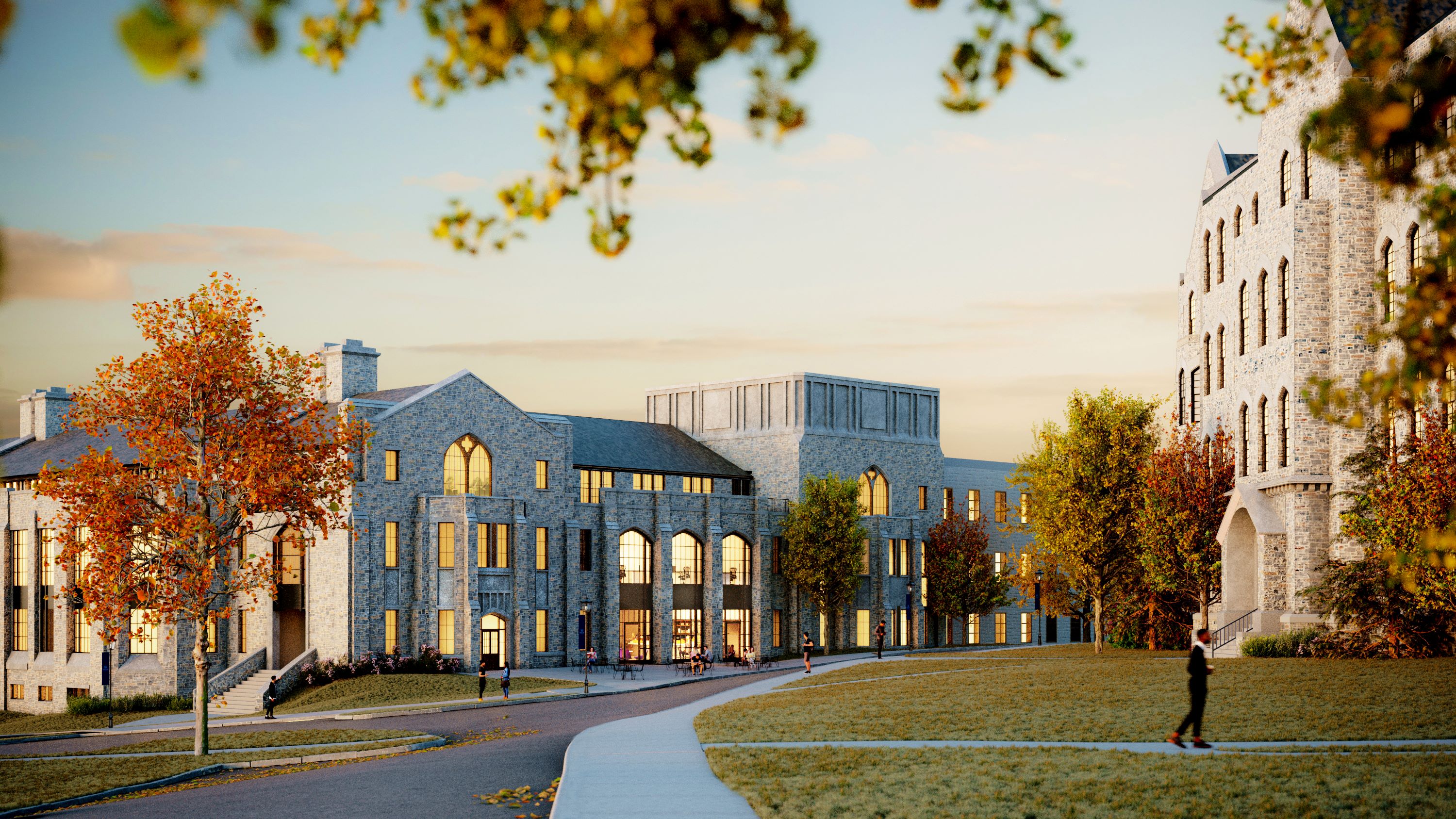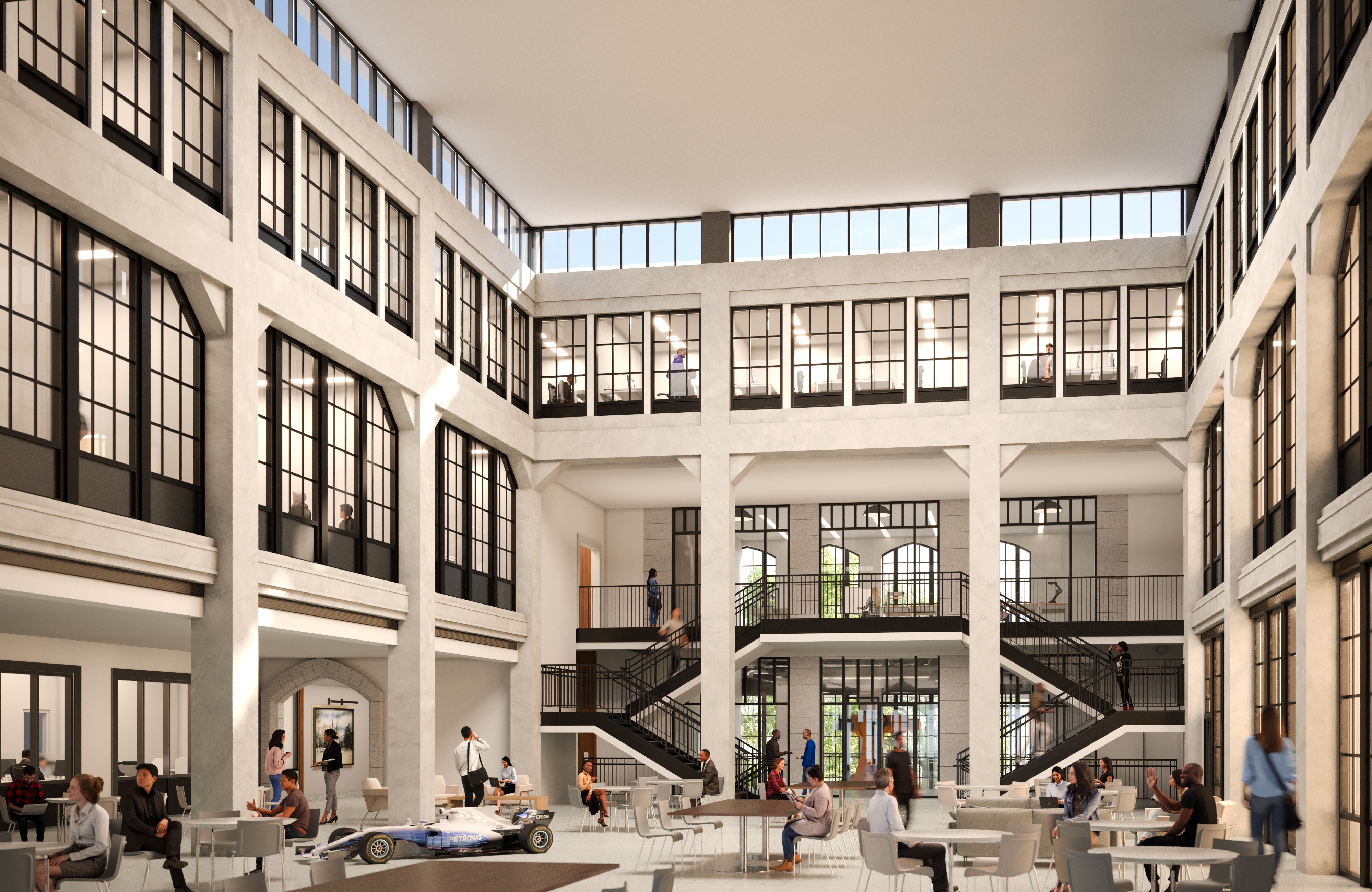
5 minute read
Behind the Blueprints
With every beam installed and concrete floor poured, excitement is growing for the rebirth of the College of Engineering’s primary academic building on campus. The $125 million construction project, which will more than double the footprint of the existing Center for Engineering Education and Research, broke ground last year with plans to open in Fall 2024 as the largest academic building on Villanova’s campus.
The 150,000-square-foot addition will allow all of Villanova’s Engineering departments to be housed under the same roof for the first time in the College’s history. Informed by years of input from faculty, staff and students, the new building advances the priorities of Villanova’s Strategic Plan, Rooted. Restless., by cultivating deeper collaborations among faculty and students and strengthening the College community as a whole.
“This project will further the College’s capabilities to foster change through interdisciplinary research and innovative teaching and learning,” says Michele Marcolongo, PhD, PE, the Drosdick Endowed Dean of Engineering. “The expansion will establish a hub for Villanova’s College of Engineering, bringing all disciplines together into one facility, which will serve as a crossroads for collaboration and innovation.”
Take a look behind the construction fence to see how the expansion project will enhance teaching and learning in the College of Engineering.
Jones Family Student Learning Commons

A gathering space at the heart of the building, the Jones Family Student Learning Commons has been designed with community in mind. Named for retired Air Products and Chemicals Chairman and CEO John P. Jones III ’72 ChE and his wife, Denise, the three-story, light-filled atrium will be an ideal space for students of all majors to gather in study groups or meet informally between classes—and potentially form new partnerships. “I think the Commons will allow students at Villanova to collaborate and talk about research ideas more freely and more comfortably compared to in classrooms or in research labs,” says Pamela Samonte ’19 MSChE, ’24 PhD, a doctoral candidate in Civil and Environmental Engineering.
Multidisciplinary Labs

The expansion will include nearly two dozen state-of-the-art laboratories, resulting in a more than 60% increase in research space. These innovative labs were designed to facilitate creativity around topical areas of research. The new Robotics Lab, for instance, “will provide a large space where students and faculty can work together to develop innovative robotic platforms for collaborative human-robot missions,” says Hashem Ashrafiuon, PhD, professor of Mechanical Engineering. “The platforms include autonomous and semi-autonomous ground, air and marine robots employed in various applications including humanitarian missions such as demining.”
Drosdick Innovation Lab

Named for John “Jack” G. Drosdick ’65 ChE, retired chairman and CEO of Sunoco Inc., and his wife, Gloria J. Drosdick, the Drosdick Innovation Lab will house 3-D printers, high-tech workstations and other essentials for the design-build-test process of engineering. The two-story maker space will also be viewable to the public, putting students’ innovations on full display. “There will be plenty of tools available for students to make things,” says Sridhar Santhanam, PhD, professor and chair of Mechanical Engineering. “They’ll all be in there working together on various projects, and that’s going to spur a lot of new innovations and new projects, and it should be exciting.”
Multifunctional Classrooms

Instructional spaces in the new building have been designed to adapt to the needs of the College. While the large lecture hall “will provide state-of-the-art instructional technologies to enhance student learning,” says David Jamison, PhD, associate dean for Undergraduate Affairs, it will also be useful when hosting guest speakers, open houses and other gatherings. “Having a large space to welcome prospective students and their families during our recruiting events will be an excellent way to show off the College’s impressive facilities,” says Gayle Doyle, associate director of Undergraduate Student Services and Program Operations.
Instrumented Green Roofs

Lab space in the expansion project stretches beyond the building’s walls to include three green roofs, adding to the extensive living laboratory of green stormwater infrastructure already on Villanova’s campus. “These sites not only help manage the building’s stormwater runoff, they’ll also serve as testbeds for students to explore research concepts and gain skills that will place them at the forefront of sustainable stormwater management practices,” says Bridget Wadzuk, PhD, ’00 CE, director of Strategic Initiatives and the Edward A. Daylor Chair in Civil Engineering.
Graduate Spaces

Master’s and doctoral students will have dedicated spaces within the new building, enhancing their on-campus experience—and strengthening the learning environment for all. With centrally located offices and communal areas, the building will seamlessly weave this growing group of engineers in with the greater College community. “Giving our graduate students a home in our new building underscores their important contributions to our College,” says Garrett Clayton, PhD, associate dean for Graduate Studies. “Not just in research labs, but as contributors to our broader mission in the classroom, in our community and beyond.”
Expanded Cafe Space

Like the original CEER, the new building will be home to a café where students, faculty and staff can refuel and catch up over a cup of coffee. “The Holy Grounds café will continue to serve as the College’s proverbial ‘water cooler’—the ideal space for relaxation and refreshment between classes or labs, an opportunity to meet up with friends and colleagues or simply laugh along with the friendly café staff,” says Keith Argue, associate dean for External Relations. “And since the coffee’s always fresh, it will always be my favorite place in the building.”
VIDEO: See how the expansion project will better enable Villanova engineers to collaborate and innovate: bit.ly/CEERvideo








